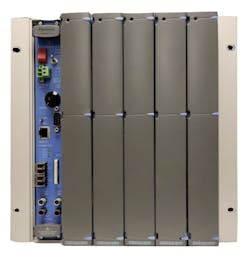Operational flexibility drives new process power generation
Q: Plants often used medium-voltage systems, particularly for powering large motors. How have these networks and their information systems changed?
A: The key point is networking. In the past, they were often medium-voltage systems, which weren’t digitalized and not networked. The latest medium-voltage controls are based on the new IEC 61850 standard, which was released in mid-January and is highly networked with high-powered, fast Ethernet networks. It helps eliminate hardwiring that previously connected different relays and motors.
By moving to a network, the overall configuration of the substation is simplified. This happened over the past 20 years. The fact is we've got all this added information from the intelligent relays at the station level, and having all that extra data lets us integrate it directly to the process control system, where business decisions are made. It enables much better situational awareness and business decision-making because it's networked.
Q: What plant interaction do operators generally have with electric power systems other than connecting with a motor?
A: I think you could say their only traditional connection was with other motors or generators. The classic distributed control system (DCS) consists of a hardwired control, start and stop status with a few interlocks going directly to all the motors. So, the situational awareness around large motors has been somewhat minimal, and occasionally inflexible with respect to the application. Instead of being hardwired, wouldn't it be great if that control was softwired by the network directly into the DCS, particularly for medium voltage?
This is starting to become important. It provides a degree of business flexibility. Information can be derived, exchanged or modified depending on changing business conditions. For the next few years, those conditions will likely be dominated by the desire to improve electric power management for climate change and for initiatives, such as green hydrogen, green diesel and biofuels. Many of these initiatives can impact the plant, and directly influence how we should integrate with electric power systems beyond what we used to do by just connecting with the load.
Q: How are fully integrated electrical controls becoming part of the new landscape of power and process control systems?
A: If we look at a power control system, we could say that a plant has an internal power distribution network. In the past, this was either a secondary SCADA system or a secondary energy management system with few connections to the DCS. These days, that integration must be much tighter because we're exchanging a lot more controls at the micro-generation level or the internal plant power exchange level, and this impacts how we operate the plant. Instead of infinite availability, power is much more rationed. It needs to be calculated. It needs to be accumulated. It needs to be managed differently when it's green power compared to when it’s not green power.
This information exchange is pushing the boundaries of what we used to do for control. Now, the modulation and changes in the electric power constraints will impact the actual process setpoints far more than they did before.
Another impact comes from electrifying plants. With green energy and net-zero carbon initiatives, heating different parts of the process is transitioning from fossil fuels to direct electric power.
We can now use green energy that’s externally or internally provided to heat processes, rather than burning fuel, and that gives plants a more carbon-neutral stance. Electrifying the process requires some aspects to be controlled using power control instead of valve control or speed control. We now have a combination of speed valve positioning and power control mixed in plant controls. That's probably the biggest change in the next few years.
Q: How fast are load-shedding control sequences, and how did they change as IEC 61850 enable information systems?
A: One might think that electrically connected or hardwired systems would be the fastest at load shedding. At present, we have record-breaking load-shedding sequences down around 29 milliseconds, which is faster than a series of relays. The 61850 Generic Object-Oriented Substation Events (GOOSE) messaging system is certainly fast enough to do very high-speed load-shedding.
Where we need fast load-shedding is debatable. If we have large motors compared to small generators that may be islanded from a grid, then load-shedding needs to be very fast to preserve the network. This typically happens in upstream oil and gas, on offshore platforms, and in liquid natural gas (LNG) plants. However, for systems with significant generating capacity, load shedding possibly doesn't need to be that fast, and we can install more basic load-shedding schemes.
However, 61850 enables developments in load shedding, complexity of load-shedding, and implementing schemes to shed loads. An interesting question is: how do you recover a plant after load shedding? What's the best way to get it back on its feet? We’ve implemented in our controllers an arrangement which enables operators to confidently restart motors only when sufficient power is available. This lets operators restart or restore the plant with confidence. In the future, there may be some artificial intelligence that can restart plants automatically, but we're not there yet.
Q: What’s the latest automation intelligence associated with plant restoration following a load-shedding event?
A: I've polled customers and technology providers and found that people are very keen to say how fast and how fantastic their automated load-shedding system is. However, load restoration is a different ballgame. I think the market, or at least the operational market, hasn't taken to the idea of restoring plants automatically. There are probably too many variables or things that might go wrong. If a plant sheds its load rapidly, its operators and engineers would have to perform fault finding. They may have to do workarounds, so an automated sequence would be difficult. At present, we allow manual restoration and automated load-shedding for optimal control and efficiency of a plant.
About the Author

Leaders relevant to this article:


